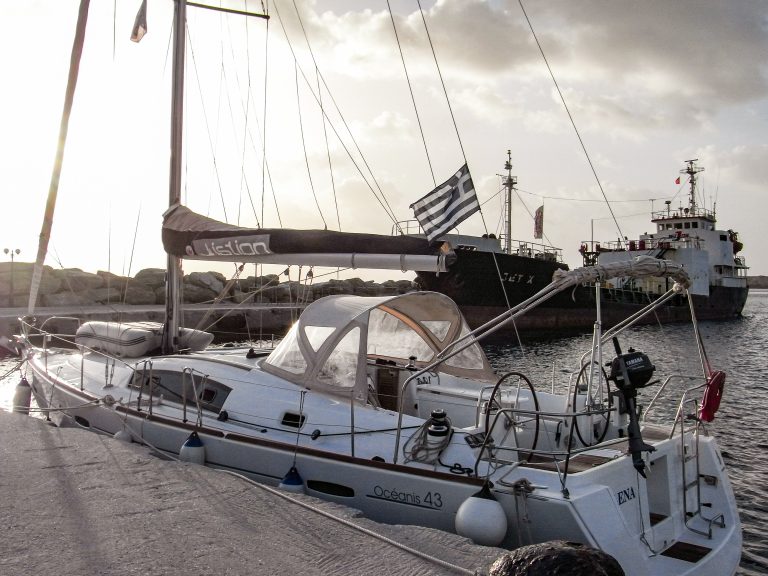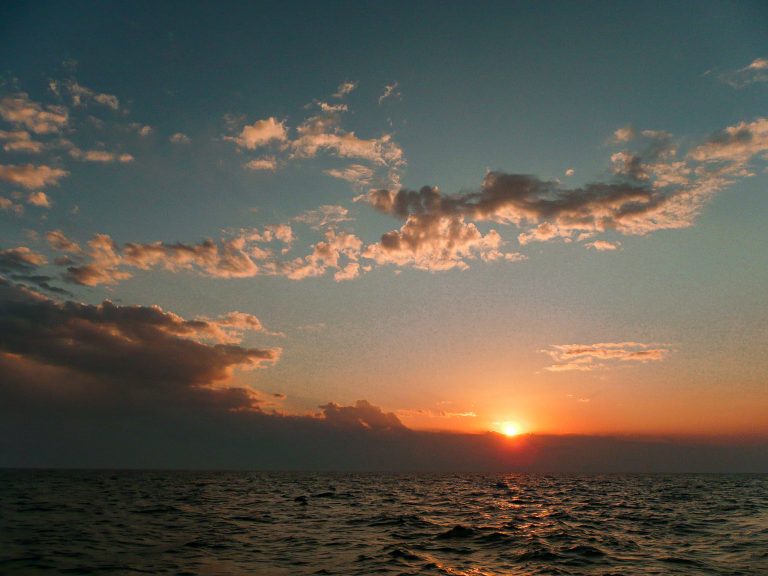
Skippertraining
Skipper training
Ein letztes Mal unternehmen Johannes und ich einen gemeinsamen Segelausflug: Wir machen ein Skippertraining, um mehr Sicherheit bei Hafenmanövern zu erlangen.
One last time Johannes and I go on a sailing excursion together: We do a skipper training to gain more confidence at port manoeuvres.
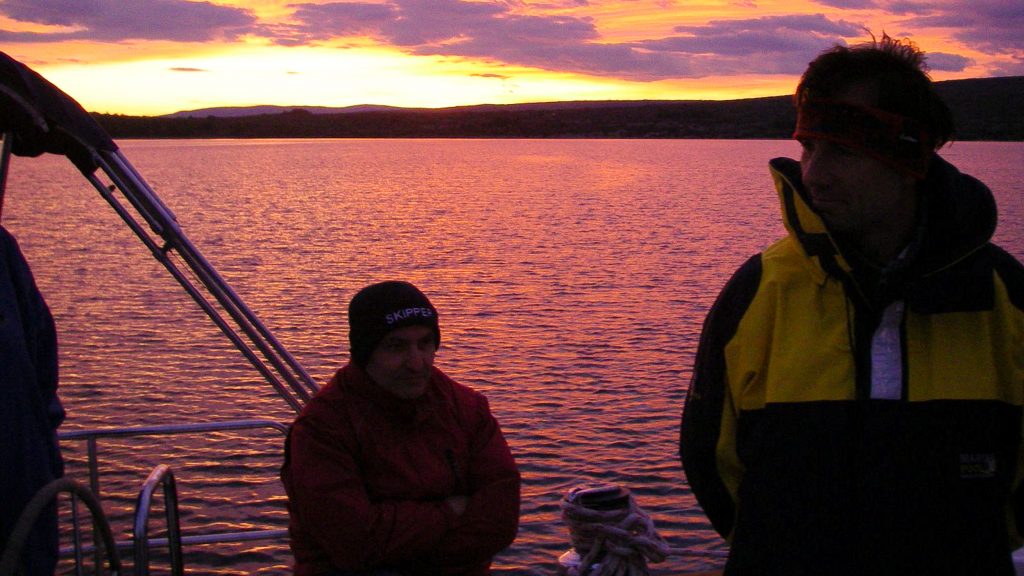
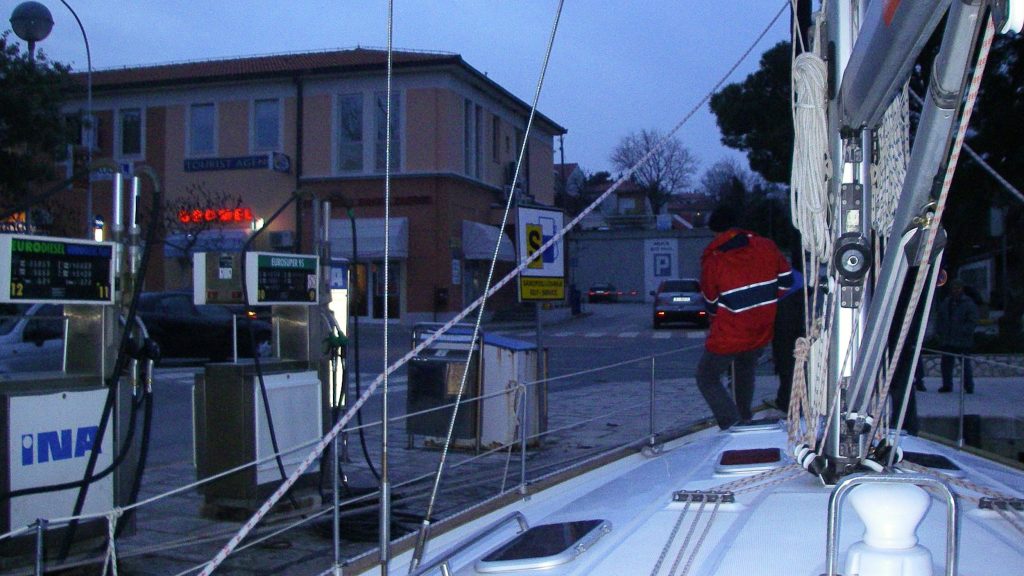
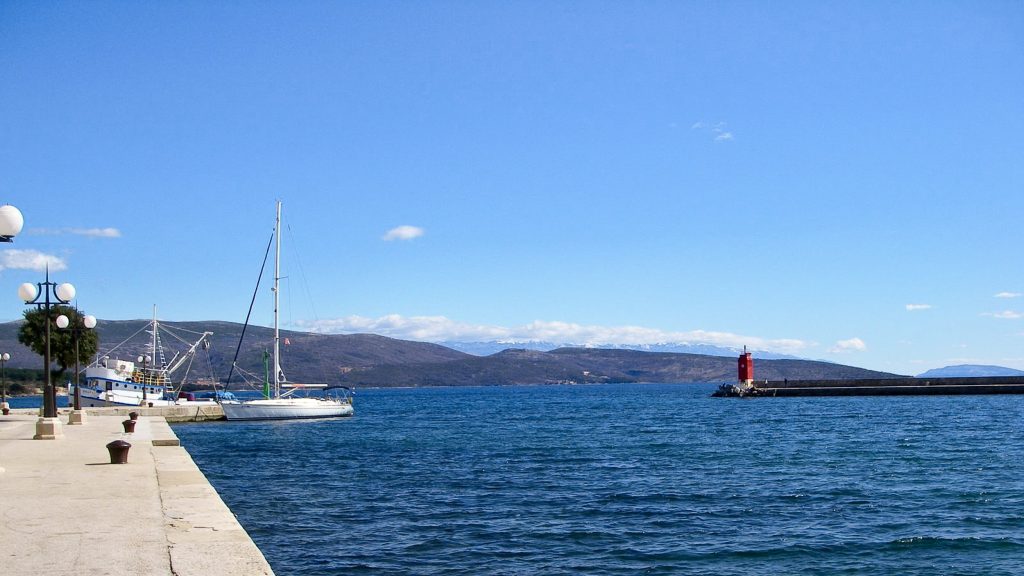
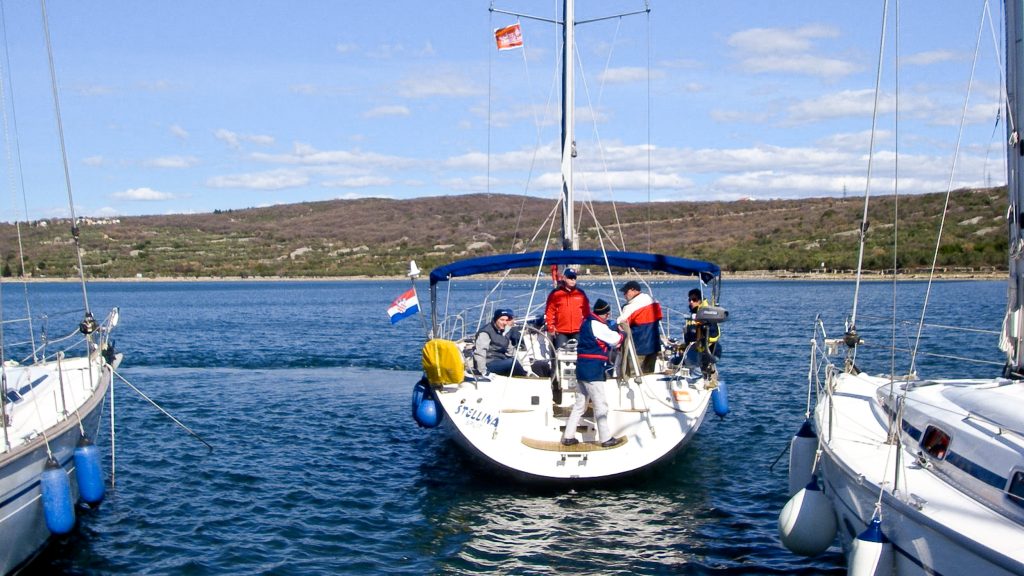
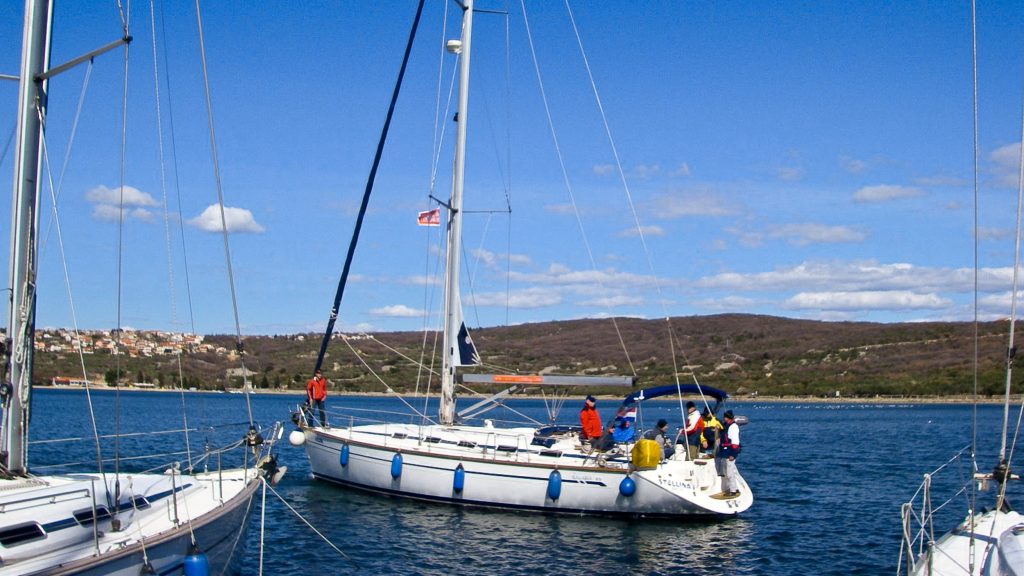
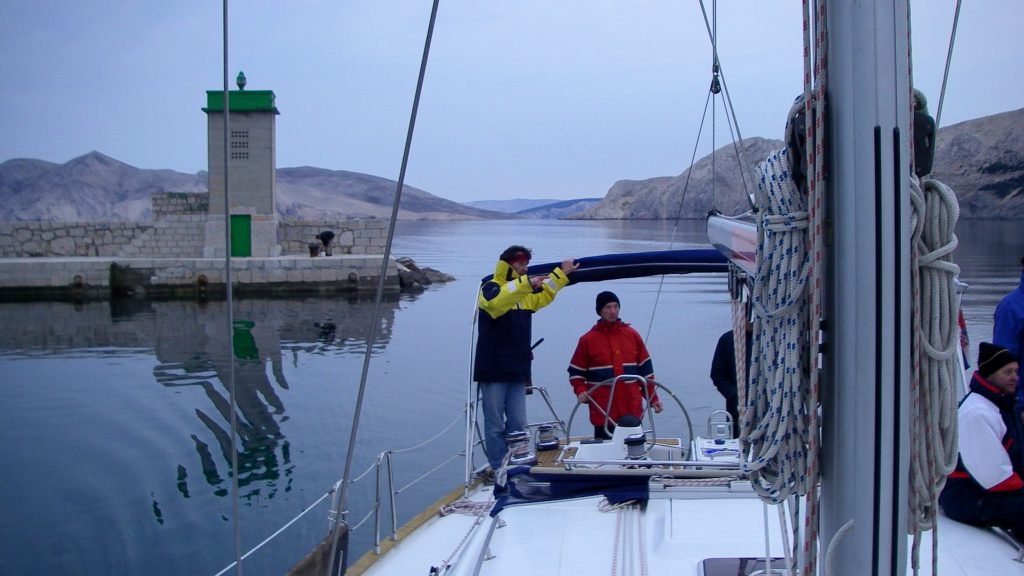
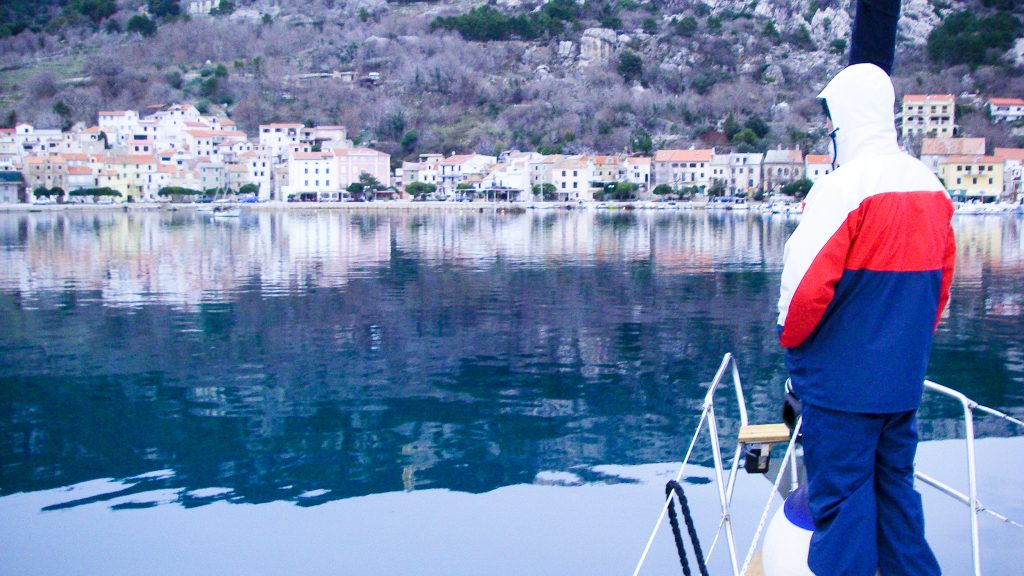
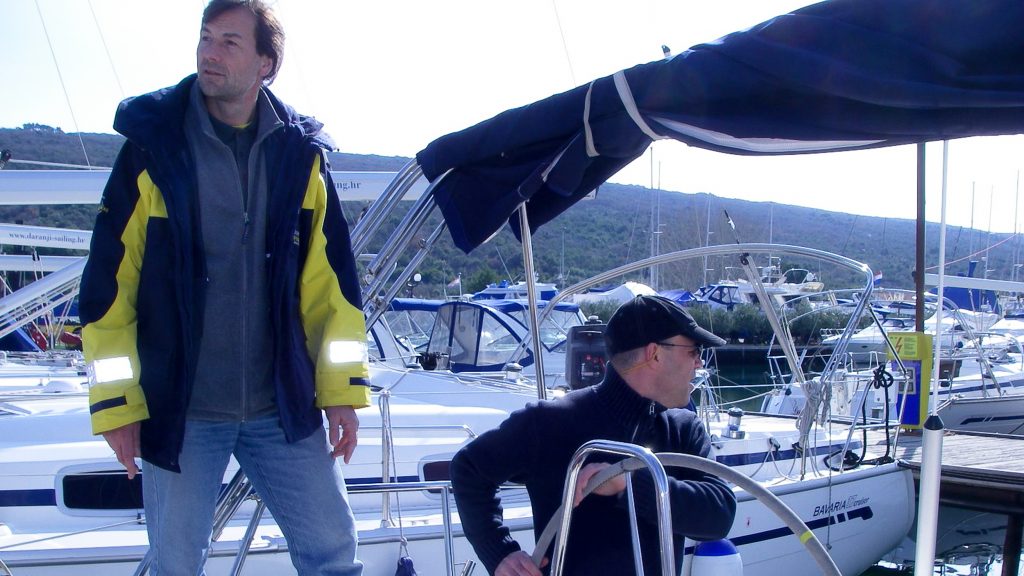
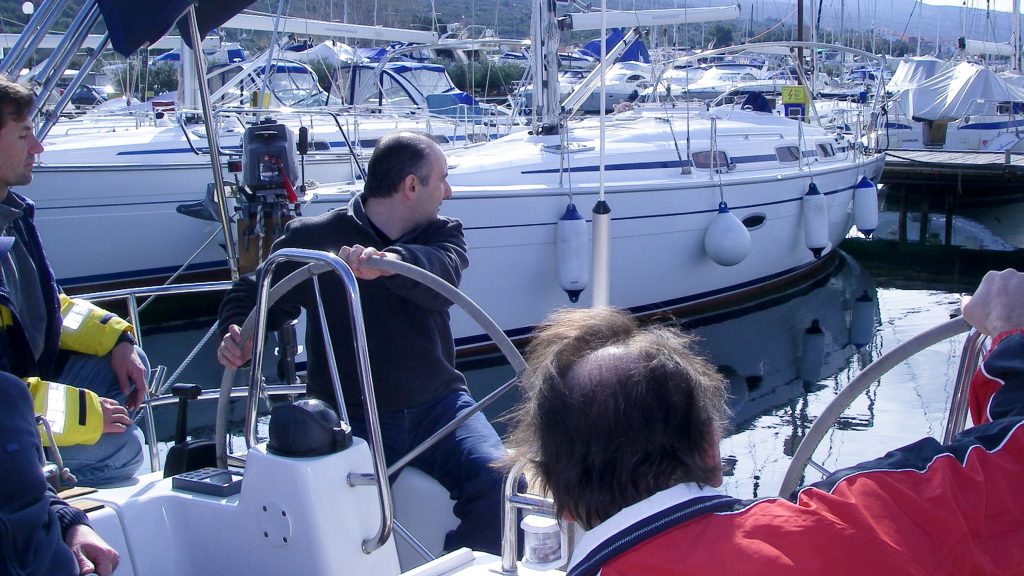
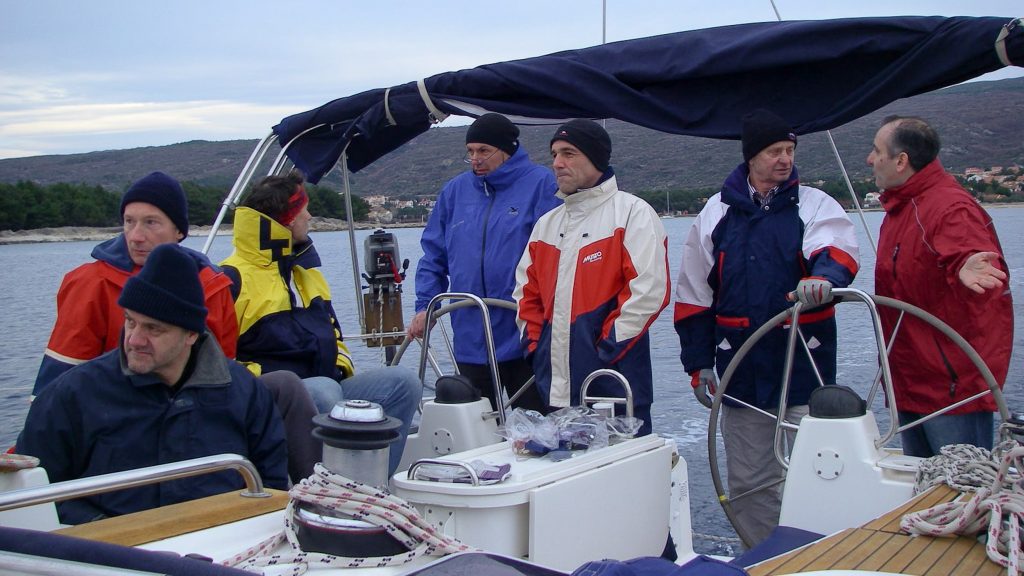
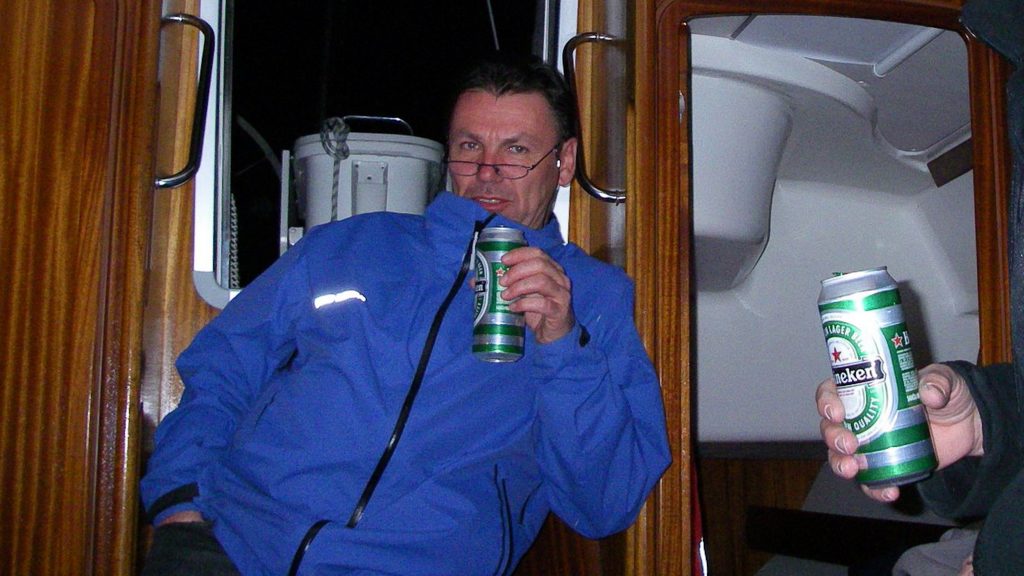
Um die Marina in Punat auf der Insel Krk herum üben wir drei Tage lang alle möglichen Anlegemanöver. Es ist Mitte März, es ist eiskalt, und das Boot ist bis zur letzten Koje belegt. Trotzdem hat mir das Training bei den folgenden Törns viel geholfen.
We practice all possible mooring manoeuvres for three days around the marina in Punat on the island of Krk. It’s the middle of March, it’s freezing, and the boat is full to the last bunk. Nevertheless, the training helped me a lot on the following trips.
Kykladen
Cyclades
Dieses Mal hatte ich ehrgeizige Pläne: in 14 Tagen wollte ich von Athen nach Ostkreta und wieder zurück segeln. Das ist nicht gelungen, aber der alternative Plan war sehr erfolgreich:
Mit 518 Seemeilen in zwei Wochen hält dieser Törn nach wie vor den Rekord.
This time I had ambitious plans: in 14 days I wanted to sail from Athens to Eastern Crete and back again. That didn’t work, but the alternate plan was very successful:
At 518 nautical miles within two weeks, this trip still holds the record.
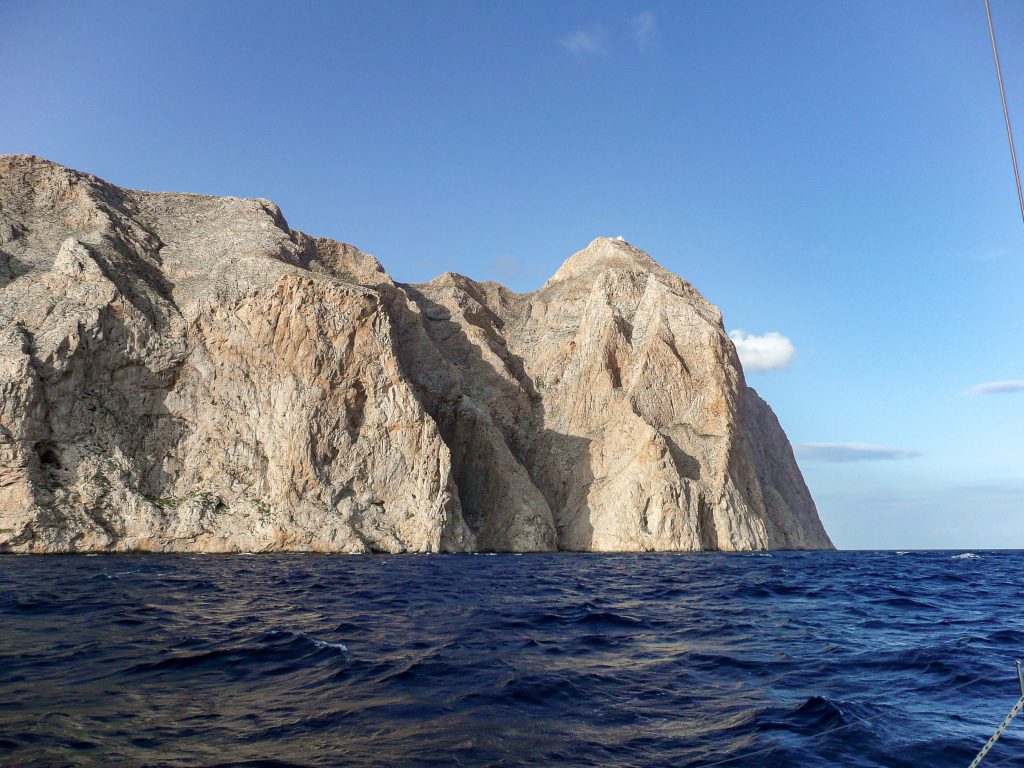
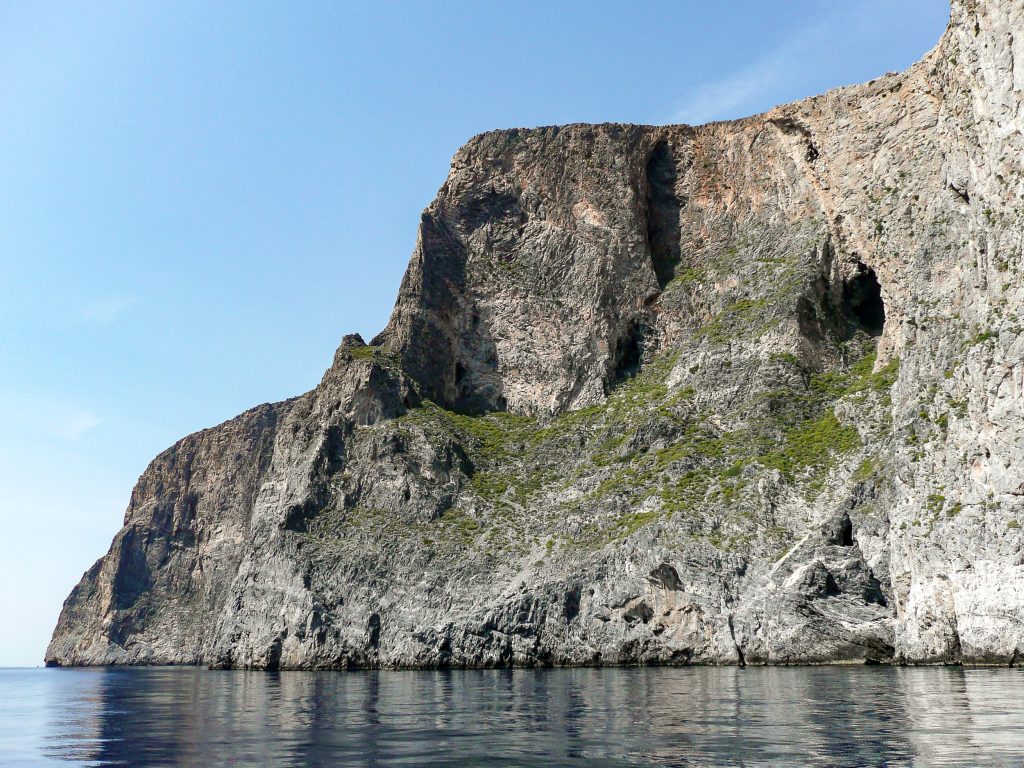
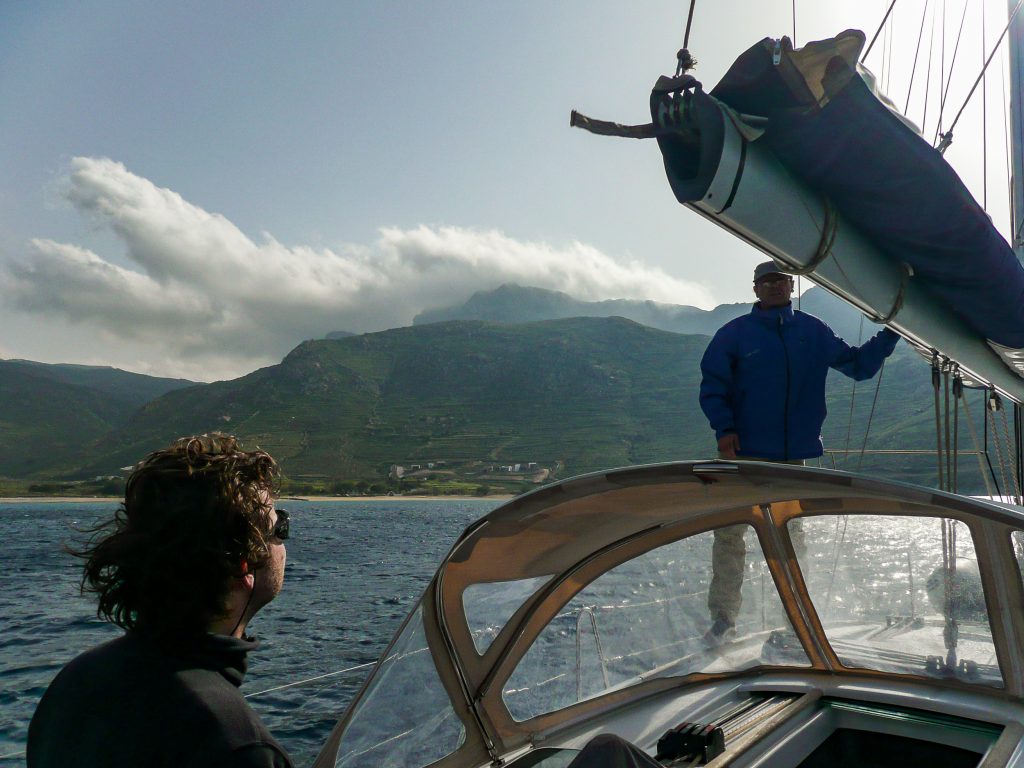
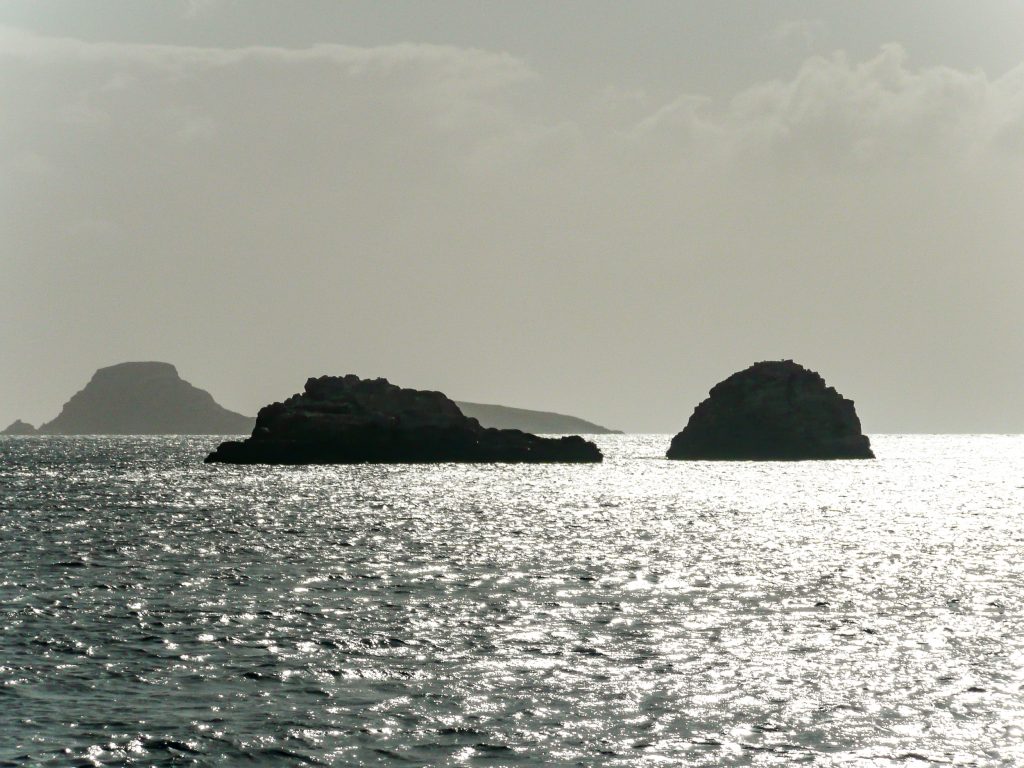
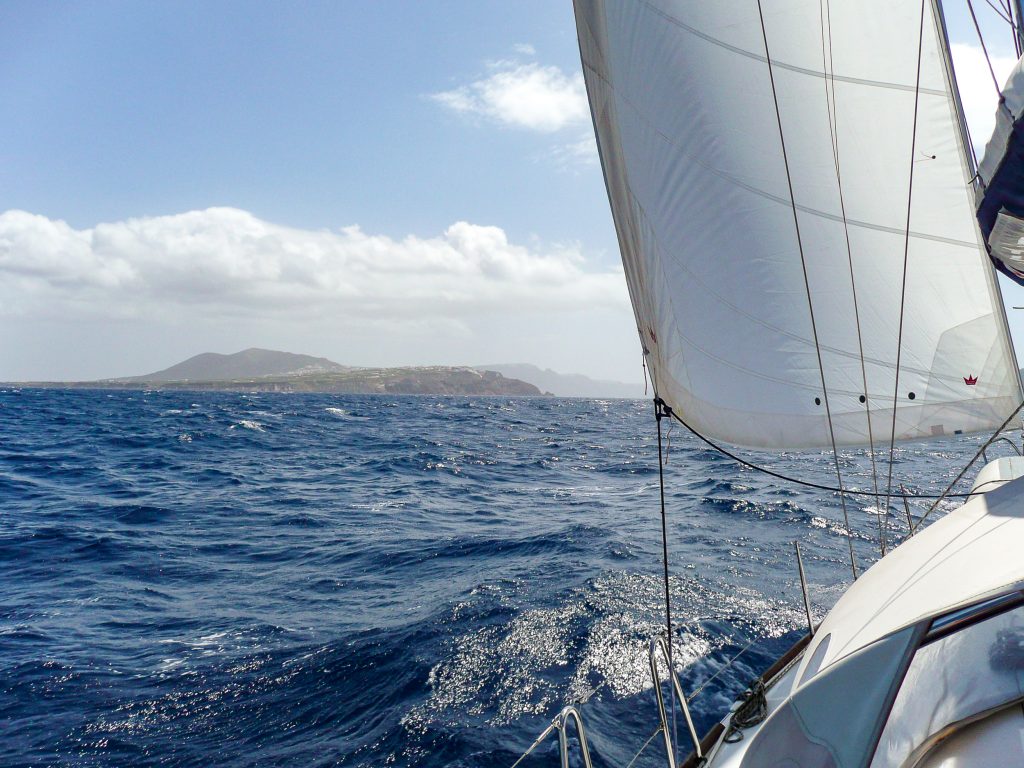
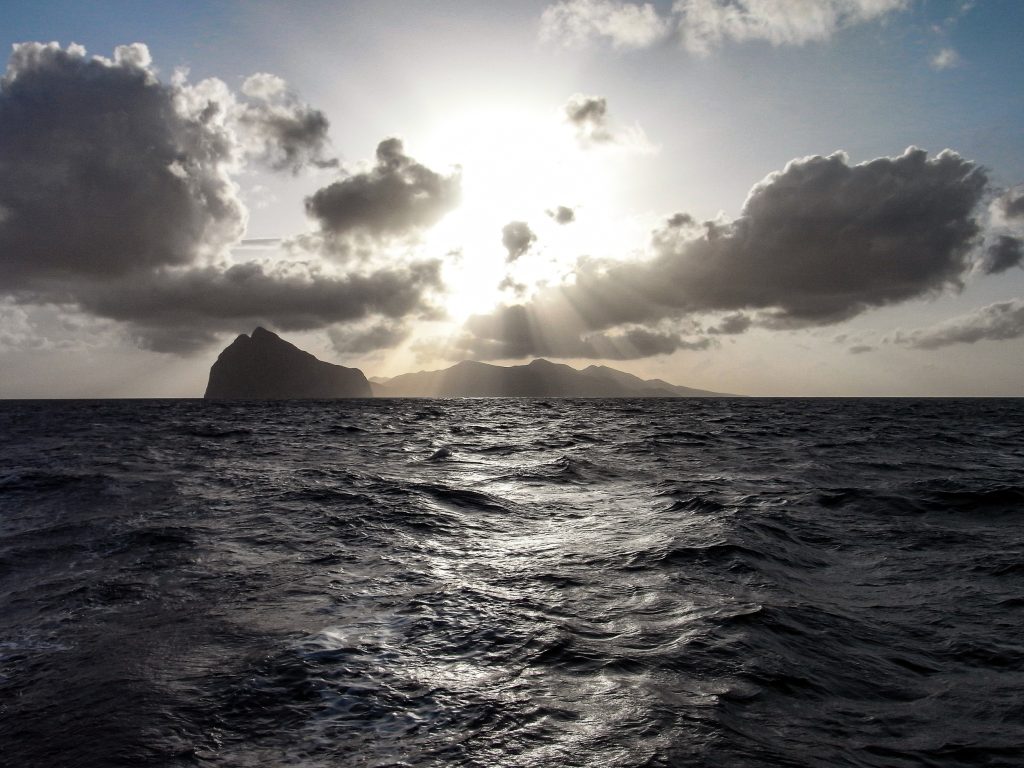
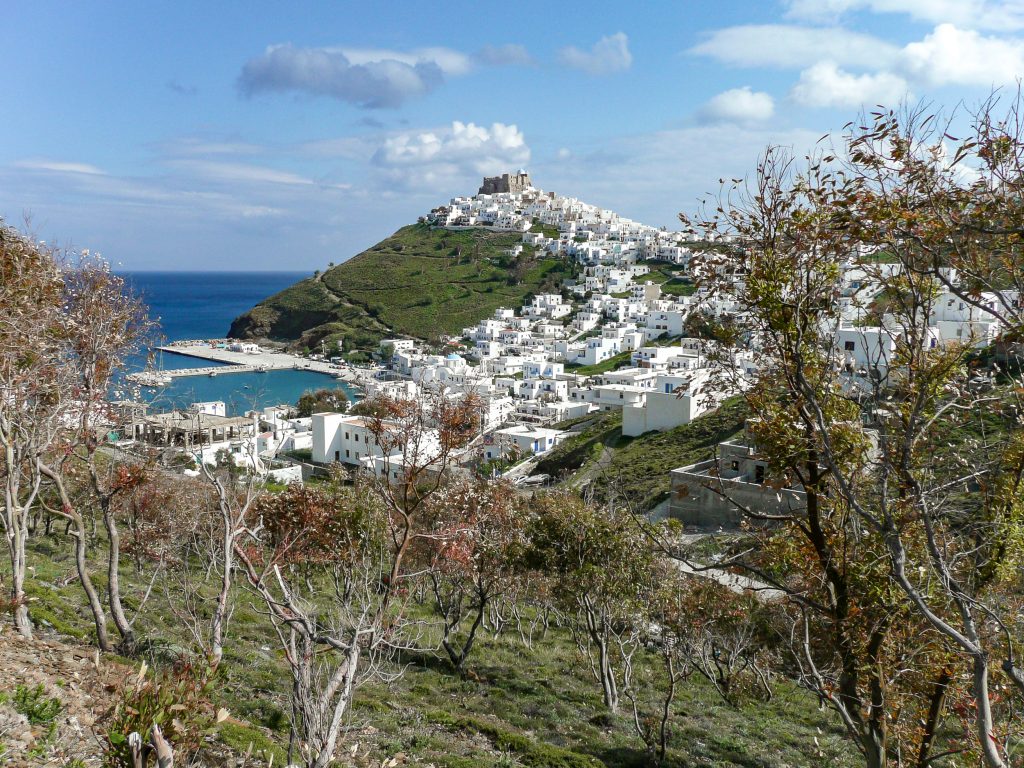
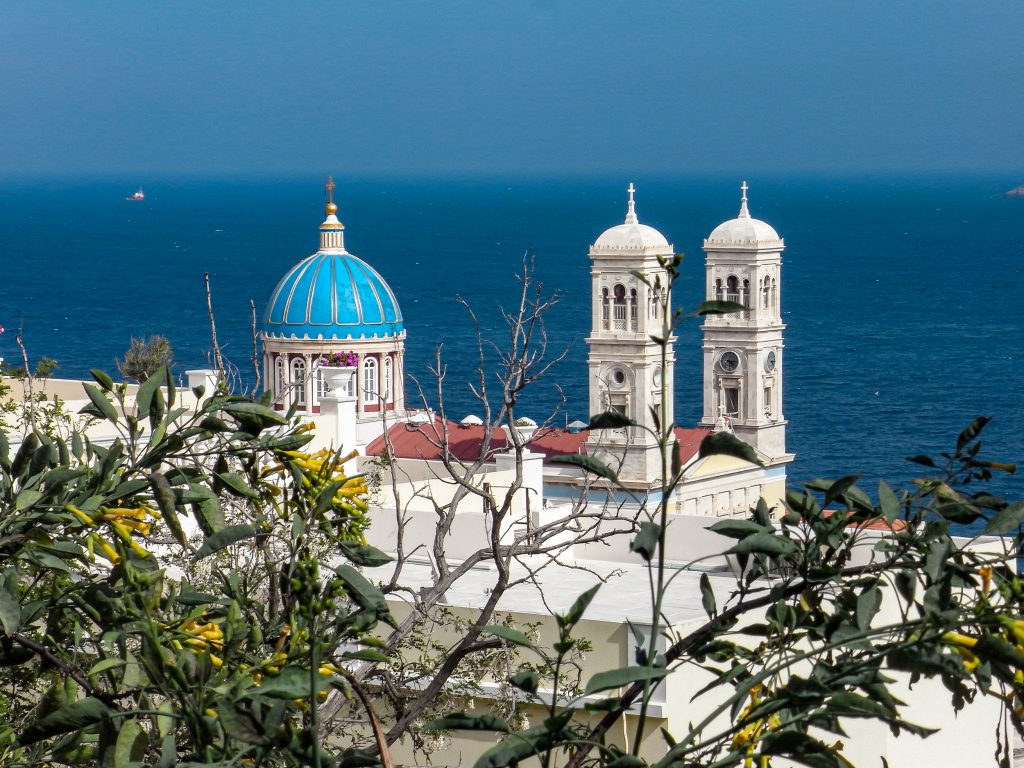
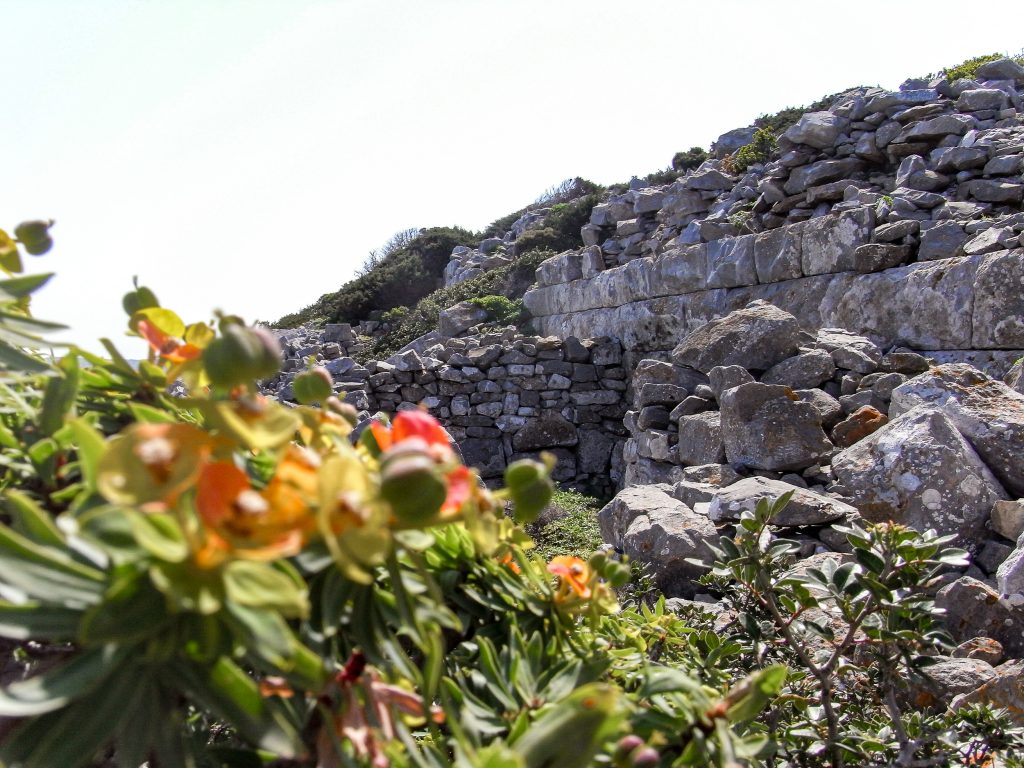
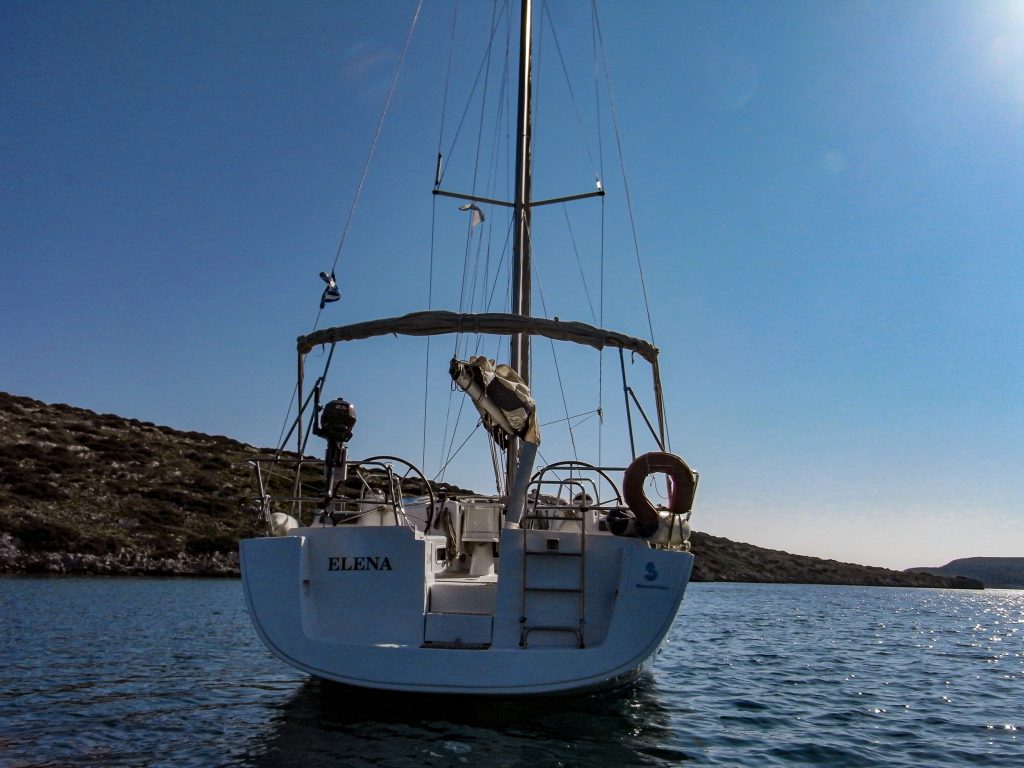
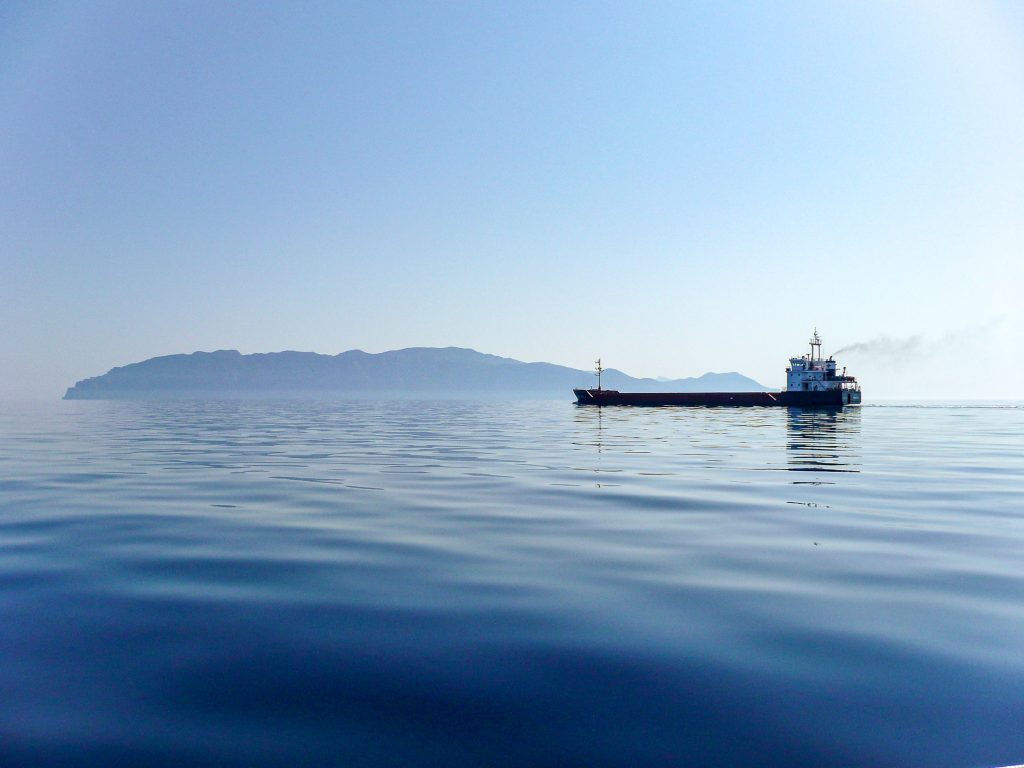
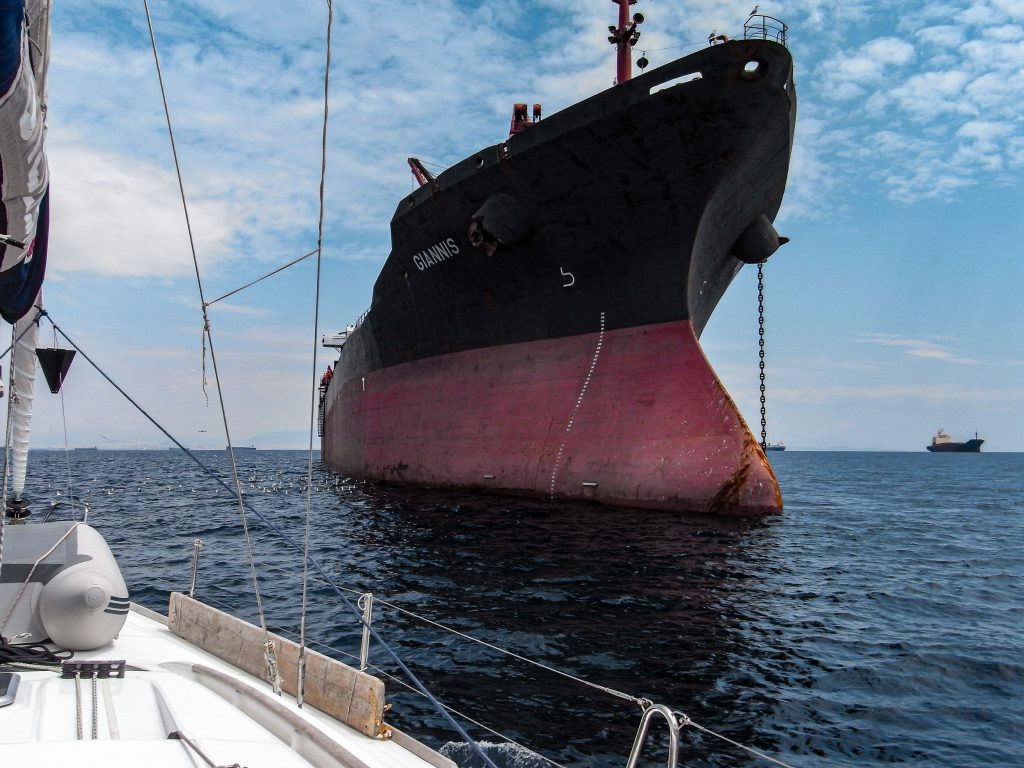
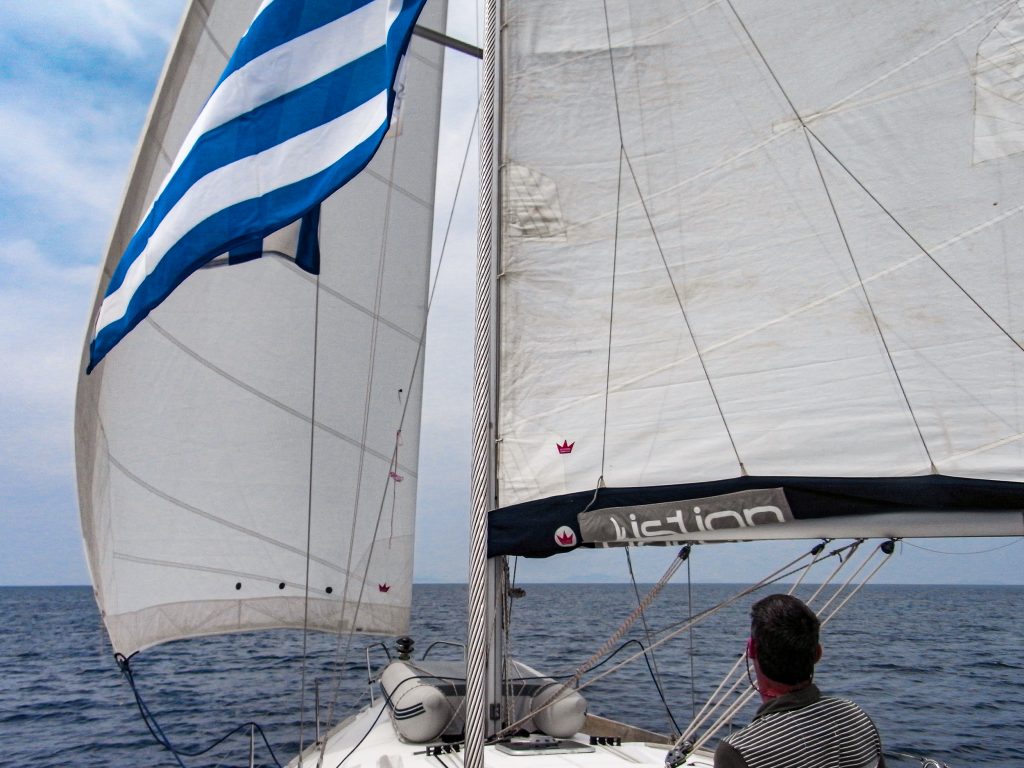
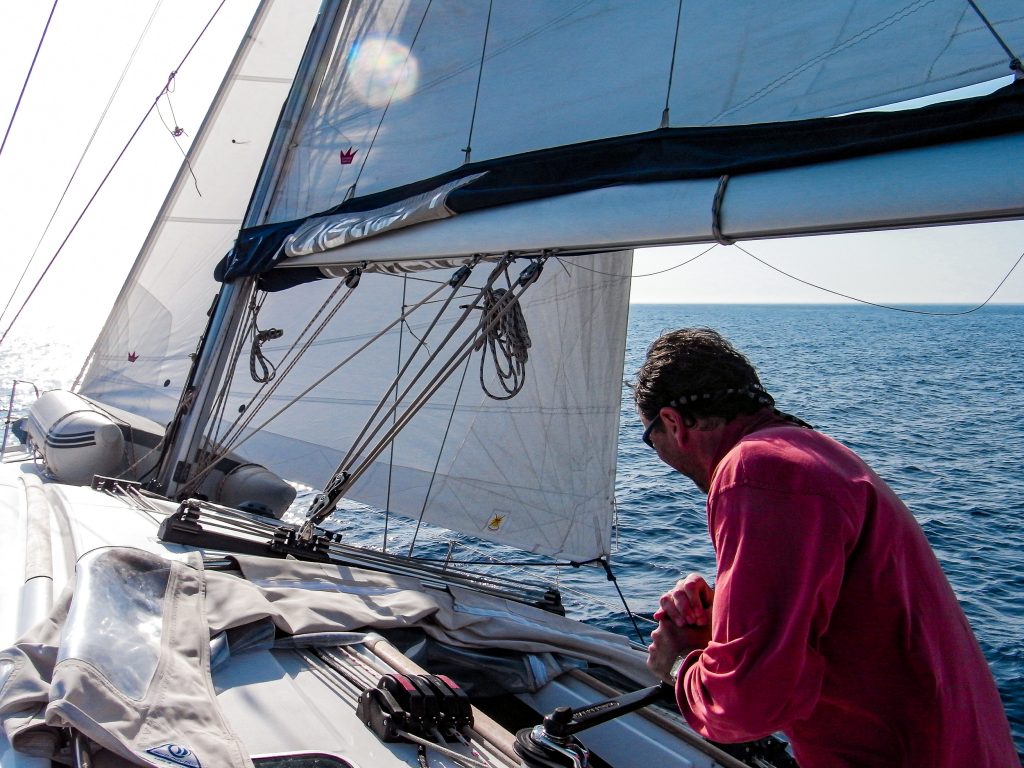
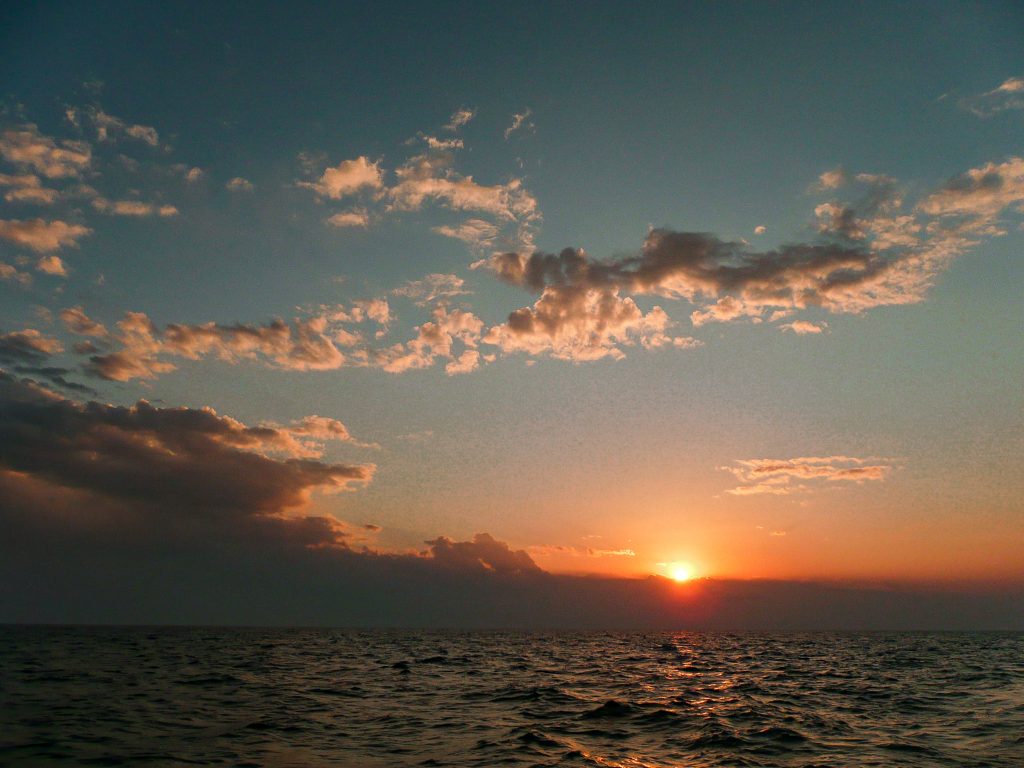
Auf den ersten Blick erschien der Plan sehr einfach. Wir würden am ersten Tag ca. 65 Seemeilen bis Sérifos (Südküste) fahren und das Boot kennenlernen. Dann würden wir zur ersten Nachtfahrt aufbrechen und am Morgen des dritten Segeltages bereits in Sitía im Osten Kretas festmachen können. Es würden uns dann zehn Tage für die Rückreise bleiben, die ja nicht einfach zu werden versprach, schließlich herrschen in der Ägäis meist nördliche Winde vor.
Die Crew würde praktisch dieselbe sein, wie das Jahr davor, nur dass Peter sich um seine junge Familie würde kümmern müssen und wir daher nur zu viert wären.
At first glance, the plan seemed very simple. On the first day we would sail about 65 nautical miles to Sérifos (south coast) and get to know the boat. Then we would leave for the first night voyage and on the morning of the third day of sailing we would be able to moor in Sitía in eastern Crete. We would then have ten days for the return journey, which did not promise to be easy, after all, mostly northerly winds prevail in the Aegean.
The crew would be practically the same as the year before, only that Peter would have to look after his young family and there would be only four of us.
Bis Sérifos sind wir dann auch im Plan. Allerdings stellt sich heraus, dass es doch nicht so einfach ist, sich auf die geänderten Bedingungen eines anderen Bootes einzustellen. Es ist das erste Mal, dass ich auf einem Charterboot mit Lattengroß unterwegs bin. Das Reffen muss also zuerst einmal geübt werden.
Obwohl wir zunächst gut vorwärts kommen, fühlen wir uns auf der Oceanis 43 noch nicht so vertraut, dass wir uns nächtliche Manöver schon sicher zutrauen würden. Dazu kommen doch ein paar unangenehme Attacken von Seekrankheit, die die Einsatzfähigkeit von Skipper und Ko-Skipper in Frage stellen. Also beschließen wir, die nächste Nacht doch nicht auf See zu verbringen, sondern im Hafen der kleinen Insel Folégandros.
We are on schedule as far as Sérifos. However, it turns out that it is not that easy to adapt to the changed conditions of another boat. It is the first time that I am on a charter yacht with a battened Mainsail. So the reefing has to be practised first, among other manoeuvres.
Although we make good progress in the beginning, we do not feel familiar enough on this Oceanis 43 that we would easily have dared to perform night manoeuvres. In addition, there are a couple of unpleasant attacks of seasickness that questioned the ability of the skipper and co-skipper to work in the middle of the night. So we decide not to spend the next night at sea, but in the port of the small island of Folégandros.
Beim Abendessen im Bergdorf der Insel diskutieren wir die Optionen: Die Fahrt nach Kreta wäre möglich, verspricht aber nicht lustig zu werden. Wir beschließen also, das Kretische Meer südlich liegen zu lassen und im Bereich der Kykladen zu bleiben. Im Süden von Santorini gibt es eine Marina, die für unsere Zwecke geeignet erscheint. Auf dem Weg dahin würden wir durch den „Krater“ fahren und etwas „Sightseeing“ machen.
Wir brechen sehr zeitig auf und haben – ungewöhnlicherweise – recht kräftigen Südwestwind. Für unseren Kurs ist das nicht ungünstig und wir kommen gut voran. Im Explosionskrater von Thira (Santorini) essen wir zu Mittag und setzen dann unsere Fahrt fort. Wir sind schon neugierig auf die pittoreske Hauptstadt der Insel…
Als wir dann jedoch vor der Marina Vlychada ankommen, müssenen wir feststellen, dass bei südlichen Winden eine so kurze steile See vor der flachen Einfahrt steht, so dass wir es nicht wagen, dort einzulaufen. Zum Glück liegt ein paar Seemeilen weiter östlich die kleine Insel Anáfi, deren südlicher Haupthafen als Alternative geeignet erscheint.
Over dinner at the island’s mountain village, we discuss the options: The trip to Crete would be possible, but it doesn’t promise to be much fun. So we decide to leave the Cretan Sea to the south and stay in the area of the Cyclades. There is a marina in the south of Santorini that seems suitable for our purposes. On the way there we would sail through the „crater“ and do some „sightseeing“.
We leave very early and have – quite unusually – some strong wind from the Southwest. That isn’t bad at all for our intended heading, and we make good progress. We have lunch within the explosion crater of Thira (Santorini) and then continue our journey. We are already curious about the picturesque capital of the island…
However, when we arrive outside the Marina Vlychada, we discover that, with southerly winds, there is such a short steep swell in front of the shallow entrance so that we do not dare to enter. Fortunately, a few nautical miles to the east there is the small island of Anáfi, whose main southern port appears to be a suitable alternative.
Als wir jedoch den kleinen Hafen erreichen, fällt uns auf, dass nicht ein einziges kleines Boot hier liegt. Der Hafen ist leer! Nachdem dies jedoch der Haupthafen der Insel ist, muss das einen guten Grund haben…
Wir beschließen also, nicht schlauer zu sein als die Einheimischen und nachdem wir nicht wissen, wo die Leute ihren alternativen – und sicheren – Liegeplatz haben, sehen wir uns gezwungen, die nächste Insel im Osten von Anáfi anzulaufen: Astipálea. Dort würden wir zwar erst gegen Mitternacht ankommen, aber der Hafen der Hauptstadt bietet bei allen Winden guten Schutz, also fahren wir weiter in die Nacht hinein.
Wir kommen kurz nach elf Uhr nachts an, und ich brauche lange, um mich für ein Längsseits-Manöver zu entscheiden, statt im Hafenbecken zu ankern. Wegen des starken Schwells liegen wir sehr unruhig und eine Festmacherleine bricht in der Nacht mit lautem Knall, aber wir überstehen die Nacht ohne weiteren Schaden ––– nur um am Morgen festzustellen, dass hinter dem nächsten Wellenbrecher eine nagelneue, kleine Marina gelegen wäre – sie war einfach noch nirgends eingezeichnet!
Während Heribert und Robert schon zum Frühstück aufbrechen, verlegen Matthias und ich die Yacht auf einen ruhigeren Liegeplatz. Hier würden wir die nächsten zwei Nächte ausruhen können.
When we reach the small port, however, we notice that not a single small boat is lying here. The port is completely empty! Anyway, since this is the island’s main port, it must have a good reason…
So we decide not to be any smarter than the locals and since we don’t know where the people have their alternative – and safe – berths, we are forced to continue to the next island to the east of Anáfi: Astipálea. We wouldn’t arrive there until around midnight, but the port of the capital offers good protection from all wind directions, so we continue into the night.
We arrive shortly after eleven o’clock, and it takes me a long time to decide to moor alongside the outer pier and not to anchor in the harbour basin. Because of the strong swell, we are lying very uncomfortably and a mooring line breaks with a loud bang during the night, but we survive the night without further damage ––– only to discover in the morning that a brand new, small marina would be located behind the next breakwater – this facility is simply not yet included in any map!
While Heribert and Robert are already leaving for breakfast, Matthias and I move the yacht to a quieter berth. Here we would be able to rest for the next two nights.
Astipálea erweist sich als „Geheimtipp“. Die Insel ist weit genug von den touristischen Hotspots der Ostägäis entfernt, hat allerdings ausreichend Infrastruktur, um es sich für ein paar Tage gemütlich zu machen. Im Übrigen sind wir hier weiter östlich als Sitía auf Kreta. Wir verbringen zwei sehr angenehme Tage auf der Insel, mieten uns ein Auto und machen ein paar Ausflüge. Am dritten Tag brechen wir auf Richtung Norden nach Levítha.
Diese winzige Insel hat einen hervorragenden Naturhafen und die einzige Familie, die noch auf der Insel wohnt, hat Bojen ausgebracht, die man für 5,00 € pro Nacht nutzen kann. Ich war bereits 2004 und 2006 auf Levítha und freue mich auf ein Wiedersehen.
Wir haben bei der Abfahrt nur sehr leichten Wind, der im Lauf des Tages komplett einschläft, weshalb wir die meiste Strecke den Motor brauchen. Nach der Ankunft ist noch Zeit auf die andere Seite der Insel zu gehen und die Sonne hinter Naxos untergehen zu sehen. Nach einer ungestörten Nacht an der Boje, machen Robert, Heribert und ich noch einen Spaziergang zum Felsen über der Ankerbucht. Dort „entdecken“ wir Spuren einer Befestigungsanlage – sie war Teil eines Systems von befestigten Alarmposten, die seit den Venezianern zum Schutz vor Piratenüberfällen in der Ägäis unterhalten wurden.
Aber auch am nächsten Tag haben wir keinen Wind, aber wir sollten weiter nach Westen kommen, damit wir am Ende keinen Stress bekommen…
Astipálea turns out to be an „insider tip“. The island is far enough away from the tourist hotspots of the East Aegean, but has enough infrastructure to make oneself comfortable for a few days. By the way, we are further east here than Sitía on Crete. We spend two very pleasant days on the island, rent a car and go on a few excursions. On the third day we set off north to Levítha.
This tiny island has an excellent natural harbour and the only family that still lives on the island has deployed buoys that can be used for €5.00 per night. I was already on Levítha in 2004 and 2006, and I am looking forward to seeing her again.
We only have very light wind upon departure, which falls completely asleep during the day, which is why we need the engine for most of the route. After arrival there is still time to go to the other side of the island and watch the sun go down behind Naxos. After an undisturbed night at the buoy, Robert, Heribert and I take a walk to the rock above the anchor bay. There we „discover“ traces of a fortification – it was part of a system of fortified alarm posts that had been in place during the rein of the Venetians to protect against pirate attacks in the Aegean. But the next day we have no wind either, but we should keep moving west so that we don’t get any stress in the end …
Wir motoren entlang der unbewohnten Insel Kinaros und erreichen schließlich Donoussa, wo wir im Vorjahr bereits eine Nacht verbracht haben. In der Nacht werden wir von Schüssen aufgeweckt, aber dann fällt uns ein, dass ja Karsamstag ist und die Nacht vor Ostern in Griechenland mit Feuerwerk und Knallkörpern gefeiert wird. Morgen ist Ostersonntag und wir wollen weiter nach Westen – Naoussa im Norden von Paros ist unser nächster Aufenthalt.
Die Fahrt dahin verläuft ruhig. Während wir zunächst bei leichtem Regen einen Vorwindkurs steuern, müssen wir nach der Nordspitze von Naxos stark anluven und kreuzen bei einer frischen Brise bis zur Hafeneinfahrt auf. In Naoussa scheinen alle Menschen auf den Beinen zu sein. Es wird Ostern gefeiert und die freundlichen Menschen geben uns das Gefühl dazu zu gehören. Dennoch, am nächsten Tag brechen wir wieder auf, um nach circa 25 Seemeilen Ermoupoli auf der Insel Siros zu erreichen.
We motor along the uninhabited island of Kinaros and finally reach Donoussa, where we already spent one night last year. During the night we are woken up by gunshots, but then we remember that it is Holy Saturday and the night before Easter in Greece is celebrated with fireworks and firecrackers. Tomorrow is Easter Sunday, and we want to go further west – Naoussa in the north of Paros is our next port of call.
The journey there goes smoothly. While we initially steer a downwind course in light rain, we have to luff strongly after the northern tip of Naxos and beat to windward until the port entrance in a fresh breeze. In Naoussa everyone seems to be on their feet. Easter is celebrated and the friendly people make us feel like we belong to their community. Nevertheless, the next day we set out again to reach Ermoupoli on the island of Siros after about 25 nautical miles.
Bei diesigem Wetter und nur leichtem Wind können wir die gesamte Strecke segeln. In Siros, wie die ehemalige Hauptstadt der Kykladen auch genannt wird, bleiben wir eine Nacht und den nächsten Tag und erkunden die Stadt, die seit Jahrhunderten für ihren Schiffsbau berühmt ist.
Am Abend des zweiten Tages brechen wir wieder auf, um mit einer Nachtfahrt die circa 60 Meilen zum Kap Sounion auf der Halbinsel Attika zu bewältigen. Obwohl der Wetterbericht nichts davon vorhergesagt hat, beunruhigt uns etwa zwei Stunden nach Aufbruch heftiges Wetterleuchten am westlichen Horizont. Gegen drei Uhr Früh wird klar, dass wir gerade auf eine Gewitterfront zufahren. Ich setze einen Kurs nach Loutra auf Kithnos ab und wir versuchen dem Unwetter auszuweichen. Wir geraten dennoch in einen Ausläufer, erleben zwei, drei gewaltige Donnerschläge und einen kurzen Wolkenbruch, dann ist alles vorbei. Bei einem herrlichen Sonnenaufgang können wir auf den alten Kurs zurückgehen und erreichen wohlbehalten die Ankerbucht an der Spitze des griechischen Festlandes – unter dem Hügel mit dem auffälligen Tempel des Poseidon, oder wie ihn Matthias blasphemisch nennt: „Poseidons Laufställchen“.
In hazy weather and only light wind, we can sail the entire route. At Siros, as the former capital of the Cyclades is also called, we stay one night and the next day and explore the city that has been famous for its shipbuilding for centuries.
In the evening of the second day we set out again to cover the approximately 60 miles to Cape Sounion on the Attica peninsula with a night sail. Although the weather report did not predict any of this, we are worried about two hours after setting out from the intense sheet lightning on the western horizon. Around three in the morning it becomes clear that we are approaching a storm front. I set off a course to Loutra on Kithnos, and we try to avoid the storm. Nevertheless, we get into an offshoot, experience two or three powerful thunderbolts and a short downpour, then it’s all over. With a wonderful sunrise we can go back to the old heading and safely reach the anchor bay at the tip of the Greek mainland – under the hill with the conspicuous Temple of Poseidon, or as Matthias calls it blasphemously: „Poseidon’s playpen“.
An einem regnerischen Tag mit wenig Wind erreichen wir nach einer ereignislosen Fahrt Aegina, die Insel, die unmittelbar vor Athen im Saronischen Golf gelegen ist. Dies ist ein idealer letzter Aufenthalt, weil man dort weniger als 20 Seemeilen vom Ziel der Reise entfernt ist. Sollte etwas schiefgehen, kann der Zwischenstopp auch ausgelassen werden und man läuft Athen direkt an. So verschafft man sich Zeitreserven und erspart sich viel Stress.
Auf einem Spaziergang durch die Gassen der Stadt höre ich aus einem Musikgeschäft hochinteressante Musik: Irgendwie klingt sie griechisch, aber das merkt man erst bei näherem Hinhören. Ich gehe in den Laden und lerne auf die Weise die Musik von Eleni Karaindrou kennen, eine griechische Komponistin, die vor allem für ihre Filmmusik bekannt wurde. Ich kaufe die CD, die gerade spielt und werde sie später als Hintergrund für meinen Fotofilm über diese Reise verwenden…
On a rainy day with little wind, after an uneventful sailing day we reach Aegina, the island that is located in the Saronic Gulf just outside Athens. This is an ideal last stop because it is less than 20 nautical miles from where you have to go. If something goes wrong, the stopover can be skipped, and you sail straight to Athens. This creates a time reserve and saves a lot of stress.
On a stroll through the streets of the city, I hear very interesting music from a record store: Somehow it sounds Greek, but you only notice that when you listen closely. I go into the store and get to know the music of Eleni Karaindrou, a Greek composer best known for her film music.
I buy the CD that is currently playing and will later use it as the background for my photo film about this trip…
110 photos with music by Eleni Karaindrou



